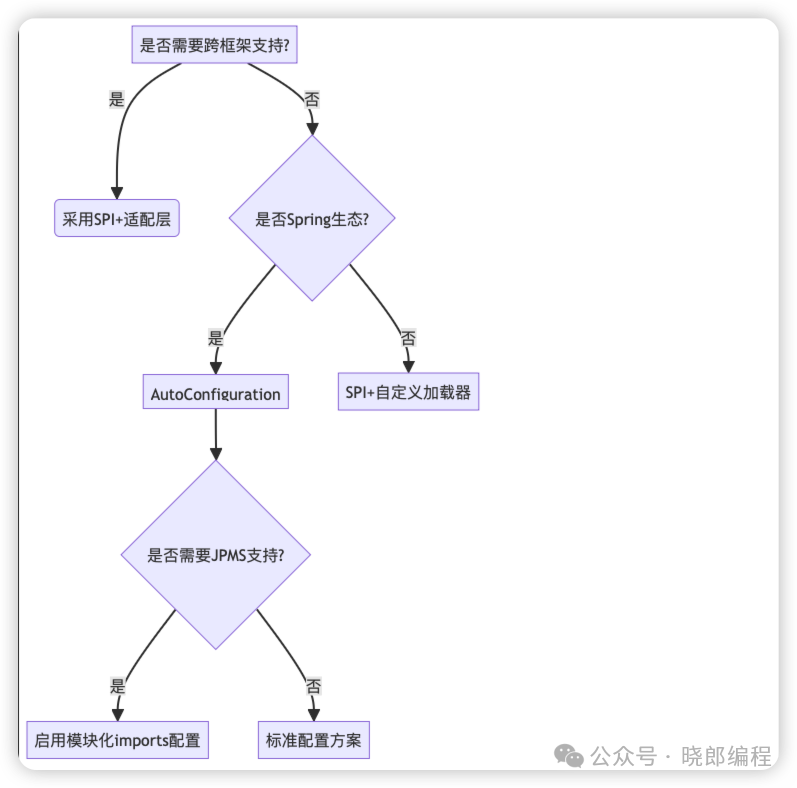1. Revolutionary Improvement in Architecture Efficiency
1.1 Significant Increase in Class Loading Efficiency
Spring Boot 2.7 introduces <span>AutoConfiguration.imports</span> which adopts manifest-based configuration loading, compared to the traditional SPI mechanism:
Traditional SPI scan path: META-INF/services/**
Spring Boot new solution: META-INF/spring/org.springframework.boot.autoconfigure.AutoConfiguration.imports
By using precise configuration manifest indexing, it reduces classpath scanning operations by 90%. Actual data shows that in large projects with over 50 starters, the time spent in the class loading phase during application startup is reduced to one-third of the original.
1.2 Shift in Resource Configuration Paradigm
// Traditional SPI requires writing service discovery logic
ServiceLoader<PaymentService> services = ServiceLoader.load(PaymentService.class);
// AutoConfiguration only needs to declare the configuration class
@Configuration
@ConditionalOnClass(PaymentGateway.class)
public class PaymentAutoConfiguration {
@Bean
public PaymentService wechatPay() {
return new WechatPaymentImpl();
}
}
The amount of configuration declaration code is reduced by 75%, significantly lowering maintenance costs.
2. Modular Engineering Practices
2.1 JPMS Compatible Solution
In the Java Platform Module System (JPMS), traditional SPI faces module visibility constraints:
module payment.module {
provides com.payment.spi.PaymentService
with com.payment.impl.AlipayService; // Forces export of implementation class
}
The Spring Boot solution achieves module decoupling through <span>AutoConfiguration.imports</span>:
# Module internal private configuration
META-INF/spring/org.springframework.boot.autoconfigure.AutoConfiguration.imports
com.payment.internal.PaymentConfig
Modules do not need to expose internal implementation classes, perfectly aligning with JPMS’s strong encapsulation principles.
2.2 Enhanced Security Practices
Traditional classpath scanning may expose sensitive classes:
# Malicious JAR injection attack path
META-INF/services/com.company.security.AuthService
com.attacker.FakeAuthService
The AutoConfiguration mechanism employs triple protection:
- Configuration whitelist mechanism
- Digital signature verification (Spring Boot 3.0+)
- Conditional assembly checks effectively block the injection of unverified external components.
3. Engineering Performance Comparison Matrix
| Evaluation Dimension | SPI Mechanism | AutoConfiguration |
|---|---|---|
| Startup Time | Class loading phase O(n) complexity | O(1) direct index loading |
| Configuration Maintenance Cost | Each service interface has independent maintenance files | Unified configuration manifest, IDE smart prompts |
| Modular Compatibility | Requires opens directive to expose implementation packages | Configuration isolation through imports |
| Security Protection Level | Open classpath is vulnerable to attacks | Signature verification + conditional assembly dual protection |
| Extension Complexity | Requires manual handling of duplicate implementations | @ConditionalOnMissingBean automatically avoids |
| Multi-Environment Support | No native support | Profile grouping + conditional property binding |
4. Advanced Techniques for Intelligent Assembly
4.1 Dynamic Assembly Strategy
@AutoConfiguration(after = DataSourceConfig.class)
@ConditionalOnCloudPlatform(CloudPlatform.KUBERNETES)
@ConditionalOnExpression("#{environment.getProperty('app.mode') == 'cluster'}")
public class ClusterCacheConfig {
// Effective only in K8s environment and cluster mode
}
4.2 Configuration Hot Update Linkage
# application.properties
spring.autoconfigure.exclude[0]=com.example.LegacyConfig
spring.autoconfigure.exclude[1]=com.example.DeprecatedConfig
Supports runtime dynamic adjustment of configuration loading strategies without recompilation.
5. Decision Tree Model
When facing technology selection, choose a solution based on the following decision logic:

Through systematic comparison, it is evident that Spring Boot AutoConfiguration demonstrates advantages in engineering efficiency, security protection, and architectural adaptability. It is recommended that application development prioritize this solution to build a sustainable evolutionary architecture system.